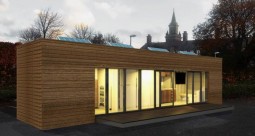
Home Delivery: Ireland’s First Shipping Container House
Home Delivery: Ireland’s First Shipping Container House – The Royal Hospital Kilmainham holds Ireland’s 1st Shipping Container Home!
THOSE visiting the Royal Hospital (the Irish Museum of Modern Art) between the 27th and the 30th of November, should take a little detour down into the field beside the gardens. Here they will be able to find and regard Ireland’s first home built out of a shipping container. The project was coordinated by Carol Tallón and Derek Trenaman of Ceardon Architects and will be donated to St Vincent de Paul upon completion.
The home, built out of an ordinary freight container, encloses a 40 square foot area and is 12 metres in length. It can house 6 people comfortably . Though this particular model is only planned for temporary accommodation, Ms Tallón believes this innovation in home building can help deal with the current housing crisis:
“Up to now, Ireland has been left some distance behind the changing global trends for housing, namely the departure from the notion of permanency or lifetime debt which has given rise to a more moveable society that needs flexibility in terms of home ownership”
The conversion from shipping container into a warm home involved 40 people, most of whom gave their time and skill freely. The container’s finally destination is Deer Park in Cork, where there is a hostel site for homeless men over the age of 18.
This form of housing, though innovative to Ireland, has been around for quite a while, most famously on an episode of Channel 4’s “Grand Designs”, where a couple built a mansion out of several container units. The first historical patent for the conversion of a shipping container into a habitable space occurred in America in 1987 by Philip C. Clarke. The Americans began to use containers for human habitation as make shift prison cells during the first Iraq war. Since then, they have become a more common feature on the housing market on the European Continent, particularly, in the Netherlands.
So what are the pros and cons of delving into this new form of housing?
- The Green argument – There is a huge amount of energy used in melting down a container. In countries whose economy is more import led than export, there is quite frequently a surplus of containers that go unused. That said Ireland is an export led economy, which means a greater demand for containers, meaning fewer left unused. In addition, the conversion of a unit into home still leaves its own carbon footprint.
- Cost Effectiveness – This is a relatively straightforward argument, the structure is already formed it just needs to be converted. Therefore, these homes are quite simply, very cheap to build.
- Ease of Construction – Following on from the above, anything that is cheap to build is also easy to build. Though the Irish project took two years, they have built a home to a very high standard with volunteers, skilled volunteers, but people donating time none the less and who have, of course, to maintain their own livelihoods too. A concentrated build could happen very quickly.
- Structural soundness – In theory, these containers are built to not only carry exceptionally heavy loads but also to deal with the toil of the sea, they are built to be strong. The flipside to this argument is that the older containers that may have experienced too much life on the sea could be susceptible to dents and therefore, rust.
- A major con about these homes is heat regulation. They are essentially large metal boxes therefore, they transmit both heat and cold very well, and this means they require insulation, which will take up already limited space inside.
- Aesthetic – Some like them, some don’t, they’re not Georgian houses, could prove difficult to get uncontested planning permission.
These are the main for/against arguments for this relatively new phenomenon. However, with correct regulation a lot of these issues can be corrected. Particularly, relating to the quality of shipping unit used. As was discussed in a recent article there is an issue of meeting demand for housing and controlling house prices and rents, particularly through public housing (link here). This could be just the ticket. While the price of these homes makes them more affordable to councils, the conversion work done would have to be of a high standard and available to both the public and private market, otherwise these buildings will be seen far from a Grand Design and more as a Grand Ghetto.









Hi There,
I am interested in this concept.
I have 4 questions.
1. Where can I view the unit – after Jan 5th 2015.
2. Can you show me a floor plan.
3. What was used for insulation.
4. What do you estimate the build cost for such a unit would be.
Regards and thanks
Shane Beary
I’m not in a position to answer your questions myself, perhaps contact Ceardean Architects, I’m sure they would be able to help with your queries
Many thanks, I shall do that.
Regards
Shane